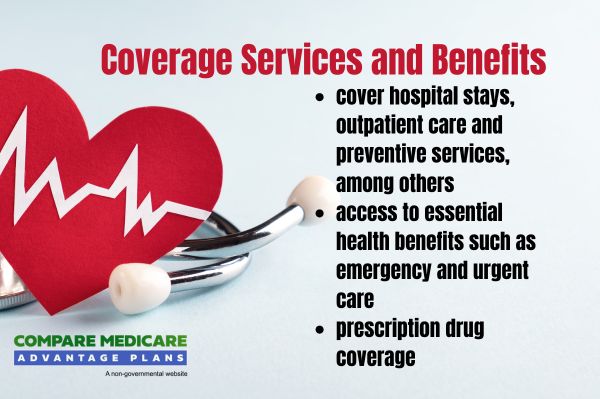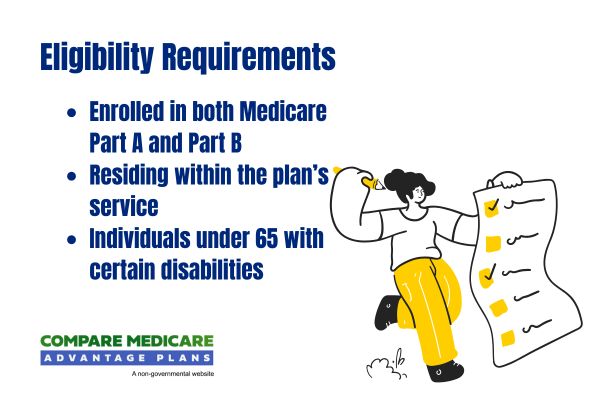Healthcare Medicare Advantage Plans 2026
The Healthcare Medicare Advantage plans
Key Takeaways
- Medicare Advantage plans combine Medicare Part A and B coverage, and might offer additional benefits like vision and dental care, while being regulated by CMS for compliance with federal standards.
- Different types of Medicare Advantage plans, including HMO, PPO, and SNPs, cater to varying healthcare needs, each with distinct cost-sharing structures and flexibility in provider access.
- Some of the Healthcare Medicare Advantage plans may offer benefits that could enhance covered services, likely reflecting an evolving landscape aimed at providing comprehensive care and potentially reducing out-of-pocket expenses for enrollees.
Compare Plans in One Step!
Enter Zip Code
Understanding Healthcare Medicare Advantage Plans 2026

Medicare Advantage plans, also known as MA plans, could provide an alternative way for Medicare beneficiaries to receive their Medicare benefits through private insurance companies. These plans combine coverage for Medicare Part A (hospital insurance) and Part B (medical insurance), sometimes including additional benefits such as vision and dental care. The recent popularity of Medicare Advantage plans is likely evident from the increasing enrollment numbers, possibly reflecting their appeal among Medicare enrollees.
The Centers for Medicare & Medicaid Services (CMS) regulate these plans to ensure compliance with federal guidelines and that they provide at least the same level of coverage as Original Medicare. Beneficiaries may choose from various plan types, including Health Maintenance Organizations (HMOs) and Preferred Provider Organizations (PPOs).
The potential cost-sharing structures, which might include premiums and out-of-pocket expenses, could vary significantly among different Medicare Advantage plans. This variability will likely allow beneficiaries to select plans that best fit their financial and healthcare needs, potentially offering more affordable coverage options compared to traditional Medicare.
Types of Healthcare Medicare Advantage Plans Available
Medicare Advantage plans may come in various forms to cater to different healthcare needs and preferences. The most common plan types include Health Maintenance Organization (HMO) plans, Preferred Provider Organization (PPO) plans, and Special Needs Plans (SNPs). Each type offers unique features and benefits, which we will explore in the following subsections.
HMO Plans
HMO plans require members to choose a primary care physician (PCP) who coordinates all their healthcare services. This structure helps manage healthcare costs by ensuring that members receive referrals for specialist visits, keeping care within a network of doctors and hospitals. This network restriction means that coverage is typically limited to in-network providers, except in emergencies.
One of the potential advantages of some Medicare Advantage HMO plans may be their low premiums compared to other plans. However, copayments and deductibles might vary widely based on the specific plan chosen. Additionally, some HMO plans might include coverage for supplemental benefits like dental, vision, and hearing services, which are not typically covered by Original Medicare.
Prior enrollment in Original Medicare Parts A and B is required to join an HMO plan. This structured approach could help improve the management of chronic conditions by having the PCP oversee and coordinate all aspects of care.
Members must use a network of doctors and hospitals for their healthcare services, which could limit flexibility but likely results in more affordable coverage and better care coordination. This network requirement, along with the need for referrals, could help keep costs down and ensures high-quality care.
PPO Plans
PPO plans offer greater flexibility in choosing healthcare providers, allowing members to see any doctor without needing referrals. This flexibility could make PPO plans an attractive option for those who want the freedom to choose their healthcare providers and access specialists directly.
However, this increased flexibility might come with higher premiums compared to HMO plans. While cost-sharing for certain in-network services may be usually lower, members may also choose out-of-network providers at a higher cost. This means that while PPO plans could offer more freedom, they also require careful consideration of the associated costs.
PPO plans might have deductibles that need to be met before coverage begins for certain services, especially for out-of-network care. Despite the higher premiums, the ability to choose healthcare providers without referrals and the broader network access could make PPO plans a preferred choice for many Medicare enrollees.
Special Needs Plans (SNPs)
Special Needs Plans (SNPs) are tailored for specific groups of individuals, such as those with chronic conditions, providing specialized benefits and care coordination. These plans are designed to meet the unique healthcare needs of their enrollees, likely offering targeted services and benefits that could go beyond standard Medicare coverage.
SNPs will likely provide tailored care and benefits, potentially making them an excellent choice for individuals with specific health conditions who require specialized attention and services. SNPs are designed to meet the specific needs of individuals, providing the necessary care and support to manage their health effectively.
Covered Services and Potential Benefits

Medicare Advantage plans will likely include comprehensive coverage, encompassing hospital care, outpatient services, and preventive health services. These services aim to promote early detection and overall health, likley ensuring that enrollees could receive high-quality care.
Supplemental benefits, which may include dental, vision, and hearing services, might be provided by some Medicare Advantage plans, which Original Medicare typically does not cover. These additional benefits could enhance the overall healthcare experience for enrollees, possibly making Medicare Advantage plans an attractive option for those seeking more comprehensive coverage.
Potential Benefits of Healthcare Medicare Advantage Plans 2026
Some Medicare Advantage plans might include additional benefits not found in standard Medicare, such as dental and vision coverage. These plans could potentially offer a streamlined care experience, likely enabling patients to receive coordinated services through a single network. This coordination could potentially lead to lower out-of-pocket costs and better management of health conditions.
Additionally, some plans may also include a cap on certain out-of-pocket expenses, which could protect members from high medical costs and offer peace of mind.
Enrollment Process for Healthcare Medicare Advantage Plans 2026
The enrollment process for Medicare Advantage plans involves understanding eligibility and choosing a suitable plan. Individuals typically need to enroll during designated enrollment periods to ensure coverage.
The following subsections will elaborate on the timing and specifics of these enrollment periods.
When to Enroll
Individuals eligible for Medicare can enroll during specific periods based on their circumstances, including their 65th birthday month. The initial enrollment period for Medicare Advantage begins three months before an individual turns 65 and extends three months after their birthday month.
From October 15 to December 7 each year, the Annual Enrollment Period (AEP) allows beneficiaries to join, switch, or drop Medicare Advantage plans. The Medicare Advantage Open Enrollment Period (OEP) from January 1 to March 31 permits one change to coverage.
Special Enrollment Periods (SEPs) enable individuals to enroll in or switch Medicare Advantage plans due to qualifying events, such as moving or losing other health coverage. These periods are essential for timely access to benefits, allowing individuals to make necessary changes based on their life circumstances.
To enroll, call one of our licensed agents at 1-833-641-4938 (TTY 711), Mon-Fri 8 am-9 pm EST.
Different Enrollment Periods
There are distinct enrollment periods for Medicare Advantage plans, namely the Initial Enrollment Period, Annual Enrollment Period, and Special Enrollment Periods. The Initial Enrollment Period spans three months before to three months after a person becomes eligible for Medicare.
The Annual Enrollment Period (AEP) typically runs from October 15 to December 7 each year, allowing beneficiaries to select or switch their Medicare Advantage plans. The Medicare Advantage Open Enrollment Period (OEP) from January 1 to March 31 allows beneficiaries to change plans or revert to Original Medicare.
Special Enrollment Periods (SEPs) are triggered by specific life events, such as relocating or losing other health coverage, allowing beneficiaries to enroll outside the standard periods. These periods provide flexibility and ensure that individuals can access the coverage they need when their circumstances change.
OEP, AEP, Special Enrollment
The Open Enrollment Period (OEP) allows beneficiaries to make changes to their Medicare Advantage plan after the Annual Enrollment Period (AEP). This period runs from January 1 to March 31 each year, providing an opportunity to switch plans or revert to Original Medicare.
Special Enrollment Periods (SEPs) allow eligible individuals to enroll in a Medicare Advantage Plan outside the normal enrollment windows due to specific circumstances. These periods are essential for those who experience life events that impact their healthcare coverage, ensuring they have access to the necessary benefits.
Potential Costs Associated with Healthcare Medicare Advantage Plans 2026

Some Medicare Advantage plans might come with additional costs compared to Original Medicare, which may include premiums, deductibles, and co-pays.
Understanding these potential costs could be crucial for beneficiaries to make informed decisions about their healthcare coverage.
Premiums and Co-Pays
Premiums for certain Medicare Advantage plans may vary significantly depending on the plan and the individual’s location. Some plans might offer lower monthly premiums, but co-pays for services may still apply.
Certain Medicare Advantage plans may also require co-pays for services, which could differ significantly between in-network and out-of-network providers. Some plans might offer additional benefits such as vision, hearing, and dental care, which could affect the overall premium cost. Certain plans may also have a tiered co-pay structure, meaning that a patient might pay a lower co-pay for primary care visits compared to specialist visits.
The potential costs associated with premiums and co-pays for Medicare Advantage plans might change annually, so reviewing the annual notices is essential. Beneficiaries should compare these costs when selecting a plan to ensure they choose the most affordable and comprehensive coverage available.
Out-of-Pocket Maximums
The out-of-pocket spending limit may be capped for individuals enrolled in certain Medicare Advantage plans. Plans that offer an out-of-pocket cap will likely be required to cover the costs of services once the out-of-pocket maximum is reached, thereby protecting members from excessive expenses. Annual out-of-pocket maximums could help beneficiaries manage unexpected healthcare expenses throughout the year.
Beneficiaries should compare out-of-pocket maximums among different Medicare Advantage plans during enrollment to find the best fit. These maximums may vary by plan, likely impacting how much enrollees will pay for healthcare services in a given year. The out-of-pocket maximums will likely be designed to protect beneficiaries from excessive costs, possibly ensuring they have a predictable limit on their yearly healthcare expenses.
This limit could provide crucial financial protection, allowing beneficiaries to plan their healthcare spending more effectively.
Covered Services and Possible Benefits
The Medicare Advantage (MA) program is required to cover all basic benefits under Medicare Parts A and B. This includes essential services such as hospitalization, outpatient care, and preventive services. Some plans may also offer supplemental benefits that could enhance the standard coverage, like vision and dental care.
How to Qualify for Healthcare Medicare Advantage Plans 2026

Qualification for Medicare Advantage plans requires enrollment in both Medicare Part A and Part B, and residency within the plan’s service area. Some plans may also exclude individuals with end-stage renal disease (ESRD) at the time of enrollment.
Eligibility can be affected by the specific requirements set by individual plans, which may vary in criteria compared to standard Medicare. Individuals may need to provide documentation of their eligibility during the enrollment process, ensuring they meet all necessary criteria.
Contracted Network and Access to Care
The proposed regulations aim to enhance the accountability of Medicare Advantage plans in providing timely access to necessary healthcare services. CMS is focusing on eliminating unnecessary barriers to care, particularly those arising from inappropriate prior authorization processes. These potential changes could help ensure that enrollees receive the care they need without undue delays.
MA plans will be required to clarify and publicly disclose their internal coverage criteria, promoting transparency and access. The regulations could potentially improve access to various services by aligning cost-sharing with Traditional Medicare’s standards, including the risk adjustment model phase and the MA risk adjustment model.
Comparing Healthcare Medicare Advantage Plans to Original Medicare
Some Medicare Advantage plans might include additional benefits that could go beyond what Original Medicare offers, such as dental, vision, and hearing care. Original Medicare provides basic hospital and medical insurance, while certain Medicare Advantage plans may offer additional benefits under a single plan.
Coverage Differences
Original Medicare does not cover routine dental, vision, or hearing services, while some Medicare Advantage plans may provide these benefits. Certain Medicare Advantage plans may also cover prescription drugs, unlike Original Medicare. These potential benefits could make MA plans more comprehensive and attractive for enrollees.
Cost-sharing structures may differ significantly; some Medicare Advantage plans may have lower premiums but higher copays compared to Original Medicare. While Original Medicare allows patients to visit any provider accepting Medicare, Medicare Advantage plans will likely restrict access to a network of providers.
These potential benefits could enhance the overall healthcare experience and will likely contribute to the growing popularity of MA plans.
Cost Comparisons

Unlike Original Medicare, certain Medicare Advantage plans might have an out-of-pocket maximum, which could help limit annual healthcare expenses. These plans may also include an out-of-pocket limit, potentially providing financial protection that is absent in Original Medicare. This cap on spending could help beneficiaries manage their healthcare costs more effectively.
Monthly premiums for certain Medicare Advantage plans may vary significantly, potentially offering lower overall out-of-pocket costs compared to Original Medicare. Beneficiaries may face lower out-of-pocket costs for certain services under Medicare Advantage than under Original Medicare, depending on the specific plan chosen. This variability likely allows enrollees to select plans that best fit their financial and healthcare needs.
Some Medicare Advantage plans may also include additional benefits such as dental and vision care, which are not typically covered by Original Medicare. These additional benefits, combined with the potential out-of-pocket maximums, could make Medicare Advantage plans an attractive option for those seeking comprehensive and predictable healthcare coverage.
Emergencies and Referrals
Medicare Advantage Plans must provide coverage for emergency room services across the entire United States. Patients enrolled in Medicare Advantage do not need referrals to access emergency services. This ensures that individuals can receive immediate care in emergencies without worrying about network restrictions or referral requirements.
Medically necessary follow-up care linked to an emergency must also be covered by Medicare Advantage Plans, ensuring continuity of care. Even if a condition turns out not to be an emergency, care is still covered if it initially appeared serious.
Summary
The Medicare Advantage plans could potentially offer a comprehensive and flexible alternative to Original Medicare, offering hospital and medical coverage, and sometimes additional benefits like dental, vision, and hearing coverage. These plans will likely continue to provide more affordable coverage and benefits for Medicare enrollees.
Choosing the right Medicare Advantage plan likely involve understanding the types available, the covered services, and the associated costs. By staying informed about the enrollment periods and comparing plans based on their potential benefits and costs, beneficiaries can make well-informed decisions to secure high-quality care. Remember, the right plan could offer protection against high medical costs and access to a wide range of services, possibly ensuring peace of mind and better health outcomes.
Frequently Asked Questions
→ What are Medicare Advantage plans?
Medicare Advantage plans are private insurance alternatives for Medicare beneficiaries, combining Medicare Part A and Part B coverage, and sometimes offering added benefits such as vision and dental care. These plans could offer a comprehensive way to receive essential health services.
→ What types of Medicare Advantage plans are available?
Medicare Advantage plans primarily include Health Maintenance Organization (HMO) plans, Preferred Provider Organization (PPO) plans, and Special Needs Plans (SNPs), each offering distinct features and benefits to cater to different needs. It’s important to evaluate these options to choose the best fit for your healthcare requirements.
→ When can I enroll in a Medicare Advantage plan?
You can enroll in a Medicare Advantage plan during your Initial Enrollment Period, the Annual Enrollment Period from October 15 to December 7, or the Open Enrollment Period from January 1 to March 31. Additionally, Special Enrollment Periods may apply for specific qualifying events.
→ What costs may be associated with Medicare Advantage plans?
Some Medicare Advantage plans might involve monthly premiums, co-pays, deductibles, and an annual out-of-pocket maximum, with costs varying based on the specific plan and location. It’s essential to compare plans to find one that fits your financial needs.
→ How could Medicare Advantage plans differ from Original Medicare?
Some Medicare Advantage plans might differ from Original Medicare by potentially offering additional benefits like dental, vision, and prescription drug coverage, and may also feature an out-of-pocket maximum for financial protection, which Original Medicare lacks.

ZRN Health & Financial Services, LLC, a Texas limited liability company




